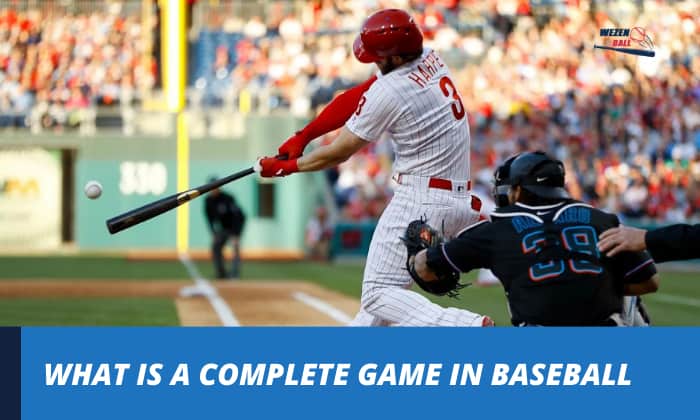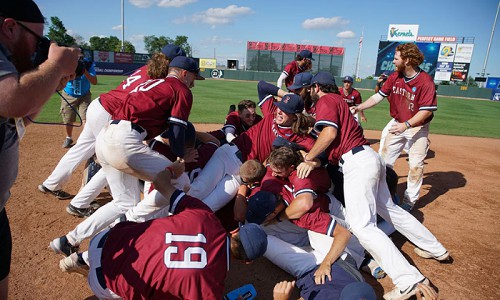The term “complete game” sparks interest amongst baseball spectators, especially those who are just getting familiar with the sport. At first glance, this phrase could mean many different things – so let’s clarify that for you.
What is a Complete Game in Baseball?
A complete game happens when a pitcher gets to pitch for his team from the beginning until the end of the match without the relief pitcher getting subbed in, regardless of the duration of the game.
Contents
Complete Game (CG) Definition
If you’re just getting acquainted with baseball, you may think that a complete game, or CG means having a game last through the duration of 9 complete innings. However, a baseball complete game is more of a pitcher’s thing among all other positions in the team.
MLB complete games happen when the main pitcher of the team achieves the feat of pitching, from the beginning until the very end of the match. For this to happen, a relief pitcher must not be subbed in any part of the game, even if it goes to extra innings.
It doesn’t matter how long or short the game lasts; as long as the pitcher plays the entire duration, even if the game is shortened, he gets a CG.
Pulling off a complete game is an indication that a pitcher is extremely good at his job – going to great lengths of controlling the game from the get-go to pull off a victory. Complete games also help keep a team’s relief pitchers well-rested and ready to play a grueling match against different opponents.
Although complete games are valuable assets to a game, they don’t happen so much in the current era of baseball.
History and Evolution of a Complete Game
Before baseball became what it is now, history shows that complete games were a common occurrence during games in the 20th century. Pitchers of the past were tasked to play the entire game, without the aid of a relief pitcher.
Now that the sport has evolved with more things to consider, complete game records have become scarce due to injury assessments of pitching all game long, and the strategy to throw off opponents by having two pitchers play at different points of the game.
Either way, here is a trend overview of games completed and recorded throughout the years in MLB history:
| Year (10-year interval) | Games started by pitchers | Games completed by pitchers | Percentage of complete games |
| 1904 | 2,496 | 2,186 | 87.6% |
| 1914 | 3,758 | 2,067 | 55.0% |
| 1924 | 2,462 | 1,198 | 48.7% |
| 1934 | 2,446 | 1,061 | 43.4% |
| 1944 | 2,484 | 1,123 | 45.2% |
| 1954 | 2,472 | 840 | 34.0% |
| 1964 | 3,252 | 797 | 24.5% |
| 1974 | 3,890 | 1,089 | 28.0% |
| 1984 | 4,210 | 632 | 15.0% |
| 1994 | 3,200 | 255 | 8.0% |
| 2004 | 4,854 | 150 | 3.1% |
| 2014 | 4,860 | 118 | 2.4% |
The statistics of complete games pitched by year show that the trend declines over the years. This reveals that this feat has become immensely rare, with pitchers only having one or two CG counts in a season or none at all.
In fact, complete game statistics in MLB season 2022 stand at only 0.7% which is an obvious downgrade from the 2.4% last recorded in 2014. Putting a face to this percentage, if we count the last complete game in MLB in 2022, the record stops at 36 CGs.
This decline may also be an effect of strict obedience to pitch counts, which entails that the main pitcher be replaced if deemed necessary, to avoid injuries due to arm overuse. Now that times have changed, 120 is the unspoken limit of the number of pitches a pitcher could be allowed to throw, as any number exceeding that could potentially trigger injuries.
Contrary to the 20th century, where complete game record was plentiful, the 21st century has not been blessed enough to witness such. Further, the data gathered through the years is a testament to the struggle of modern-baseball pitchers.
Complete Game Rules
To understand the rules of complete games, there are two points to remember:
- The duration of innings wouldn’t matter for as long as a pitcher gets to start and end the game with him calling the shots, he is awarded a complete game.
So in scenarios where the pitcher is relieved in extra innings, he will not qualify for such a feat.
- In official games where delays happen, the pitcher will still get a CG if he starts the game and is still inside the field at the time it is
All-time Career Leaders
When we talk about the pitcher who tallied the most complete games in the MLB, Cy Young is the name to remember. Young has recorded 749 complete games, with experts predicting that this record will stay unbeaten for years to come.
He is then followed by Pud Galvin with 646 and Tim Keefe with 554.
Conclusion
Complete games are rare to see. When we watch one live or on TV, we’ll know that we have just witnessed greatness in sport – poetry in motion.
Pitchers who have achieved this milestone are for sure some of the greats in baseball, as this accomplishment has been hard to come by in recent years. It takes a formidable player with exceptional athleticism and discipline to secure a complete game in baseball.
Now that you know what is a complete game in baseball, it’s our hope that you continue learning more about the sport.
Thanks for stopping by!

A powerful swing and the ball is flying across the field, just one hit, and we might never forget the thrill it brings. I do not know about you, but I never do. Every baseball game is the chance to compete with others and cooperate with your teammate. It is among my biggest passions.
















